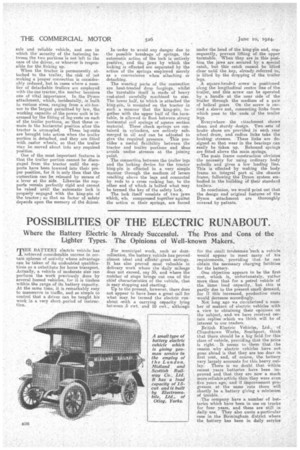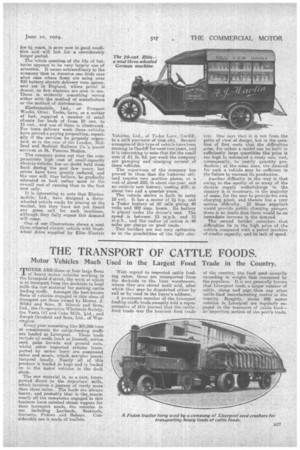POSSIBILITIES OF THE ELECTRIC RUNABOUT.
Page 22

Page 23

If you've noticed an error in this article please click here to report it so we can fix it.
Where the Battery Electric is Already Successful. The Pros and Cons of •the. Lighter Types. The Opinions of Well-known Makers.
THE BATTERY electric vehicle has achieved considerable success in certain spheres of activity where advantage can be taken of its undoubted qualifications as a substitute for horse transport. Actually, a vehicle of moderate size can perform the work previously done by several horsed vehicles, for it is tireless within •the range of its 'battery capacity. At the same time, it is remarkably easy to manceuvre in traffic, and so simple to control that a driver can be taught his work in a very short .period of instruction.
For municipal work, such as dustcollection, the battery vehicle has proved. almostideal and effeeta\great savings. It has also proved most Valuable in delivery work where the daily 'mileage does not exceed, say 35, and where the number of stops brings out one of the chief characteristics of the vehicle, that is easy stopping and starting. Up to the present, however, there does riot appear to have been a 'great call for what may. be termed the electric runabout 'with a carrying cirpa.city lying between .5 cwt. and 10 cwt., althougn.
for the small tradesman ',such a vehicle would appear to meet. many of his requirements, providing that he can obtain the necessary charging facilities for the battery.
.One objection appears to be the first cost, which is, unfortunately, -rather more than that for a petrol vehicle of the Same load capacity, but this is partly due to the present small demand, for if this increased, production costs would decrease accordingly.
Not long ago we circularized a number of makers of electric vehicles with a view to obtaining their opinions on the subject, and. we have received certain .replies -which we think will be of interest to our readers.'
British Electric Vehicles, Ltd., -of Churchtown Works, Southport, think that there should be a big field for this 'class, of vehicle, providing that the price is right. It seems to them that the reasbn why electric vehicle's have not gone ahead is that they are too dear in first cost, and, of course, the, battery, very largely accounts for this heavy outlay. There. is no doubt that within recent years batteries have been improved and that they are now a much more reliable article than they were even five years ago, and if improvement progresses, at the same rate there will shortly be a battery giving a minimum cif trouble.
The company have a number of batteries which have been in use on trucks for four years, and these are still in daily use. They also quote a particular case in the Birmingham district where the. battery has been in daily seryiee for 61 years, is even now in good condition and will lest for a considerably longer period.
The whole question of the life of batteries appears to be very largely one of attention. It seems extraordinary to the eempany that in America one finds case after case where firms are using over 1(X) battery electric delivery vans apiece, and yet in England, where petrol is desarer, so few elects-lea are seen in use. Then° is evidently something wrong either with t,he method of manufacture or the method of distribution.
Eleotromobile, Ltd., of Prospect Works, Otley, Yorks, have, as a matter of fact, supplied a number of small chassis for loads of from 10 cwt. to 15 cwt., and one of these is illustrated. For town delivery work these vehicles have proved a paying proposition, especially if the services be properly organized, as in the case of the London, Midland and Scottish Railway Co.'s parcel services at St. Pancras Station.
The company paint out that the comparatively high cast of small-capacity eleotrio vehicles has no doubt held them back during the pest few years, but prices have been greatly reduced, and the user will, they believe, be gradually educated to look rather more to the overall cost of running than to the first cost only.
It is interesting to note that Electi-omobile, Ltd., have designed e threewheeled vehicle ready for placing on the market, but they have not yet found any great call for such machines, although they fully expect this demand will come.
One of our illustrations shows A neat, three-wheeled electric vehicle with frontwheel drive supplied by Elite Electric
Vehicles, Ltd., of Tudor Lane, Cardiff, to a milk purveyor of that city. Several examples of this type of vehicle have been running in Cardiff for over two years, and it is interesting to note that for the small sum of 21 2s. 6d. par week the company are garaging and charging several of these vehicles.
The experience of the company has proved:to them that the hatteries utilized require now positive plates, at a cost of about 222, in about one year, and an entirely new battery, costing 25:5, in about two and a quarter years.
The vehicle shown is built to carry 10 cwt. It has a motor of 21 h.p. and a Tudor battery of 20 cells giving 40 volts and 200 amp. hours. Its battery is placed under the driver's seat. The speed is between 12 m.p.h. and 15 m.p.h., and the radius of action is 40 miles per charge on good roads.
Two builders are not very optimistic as to the possibilities of the light elec tric. One says that it is not from the point of view of design, but in the question of first costs that the difficulties arise, for unless a model can be built iii sufficiently large quantities the price is too high to command a ready sale, and, consequently, 'to justify quantity production; at the same time, the demand for such a vehicle may be sufficient, in the future to warrant its production.
Another difficulty in the way is that owing to the apathy of so many of the electric supply undertakings in the comitry it is necessary, in the majority of cows, for the user to provide-his own charging plant, and therein lies a very serious difficulty. If these suppliers would provide public charging garages, there is no doubt that there would bean immediate increase in the demand.
The second builder considers . that difficulties lie in the high price of the vehicle compared with a petrol machine of similar capacity, and its lack of speed.
































